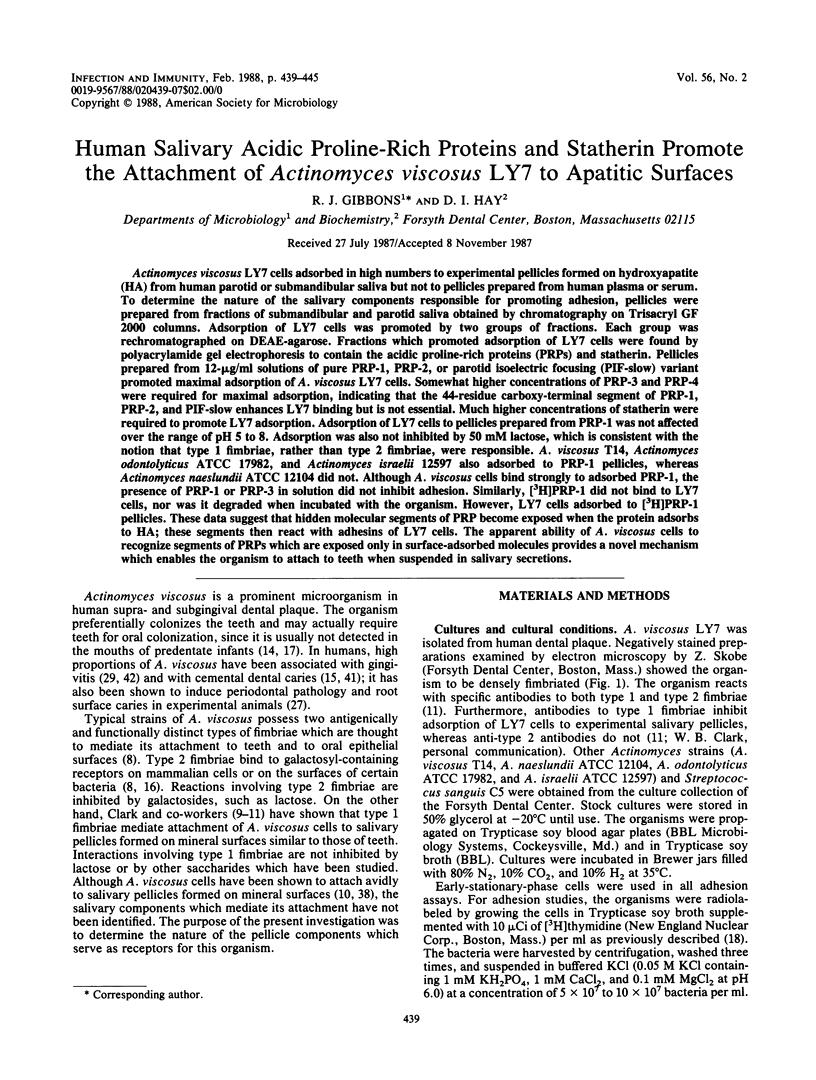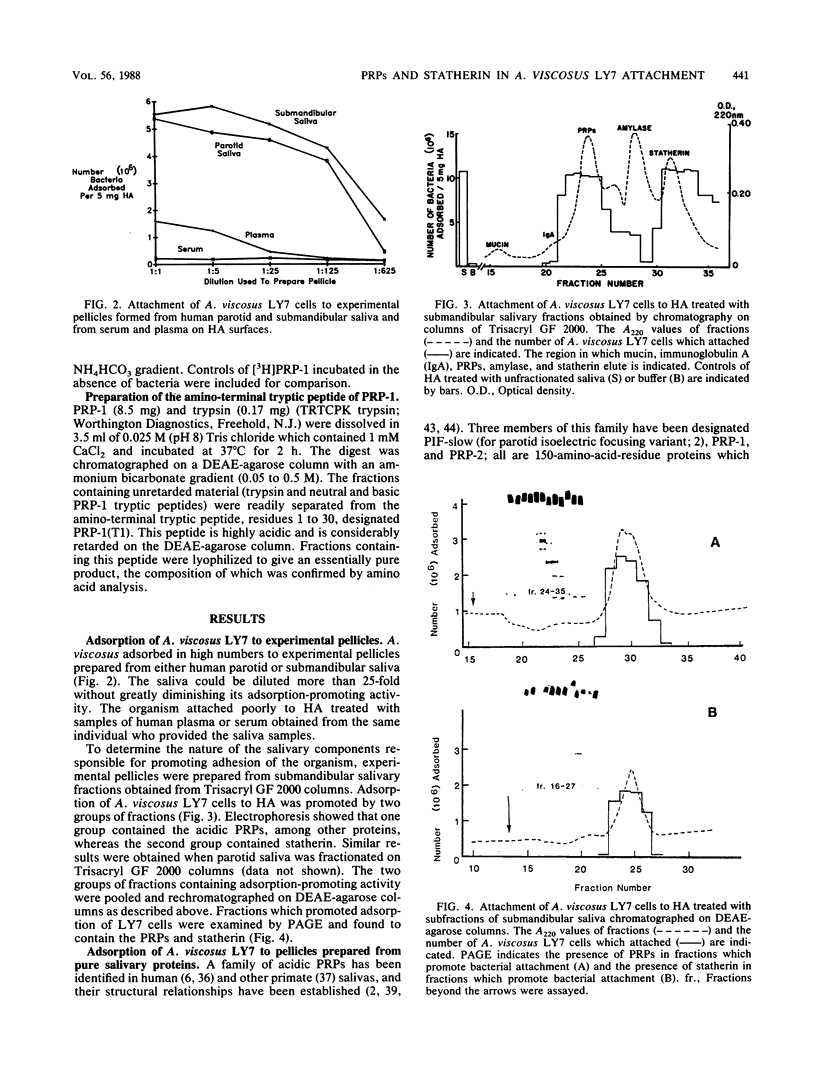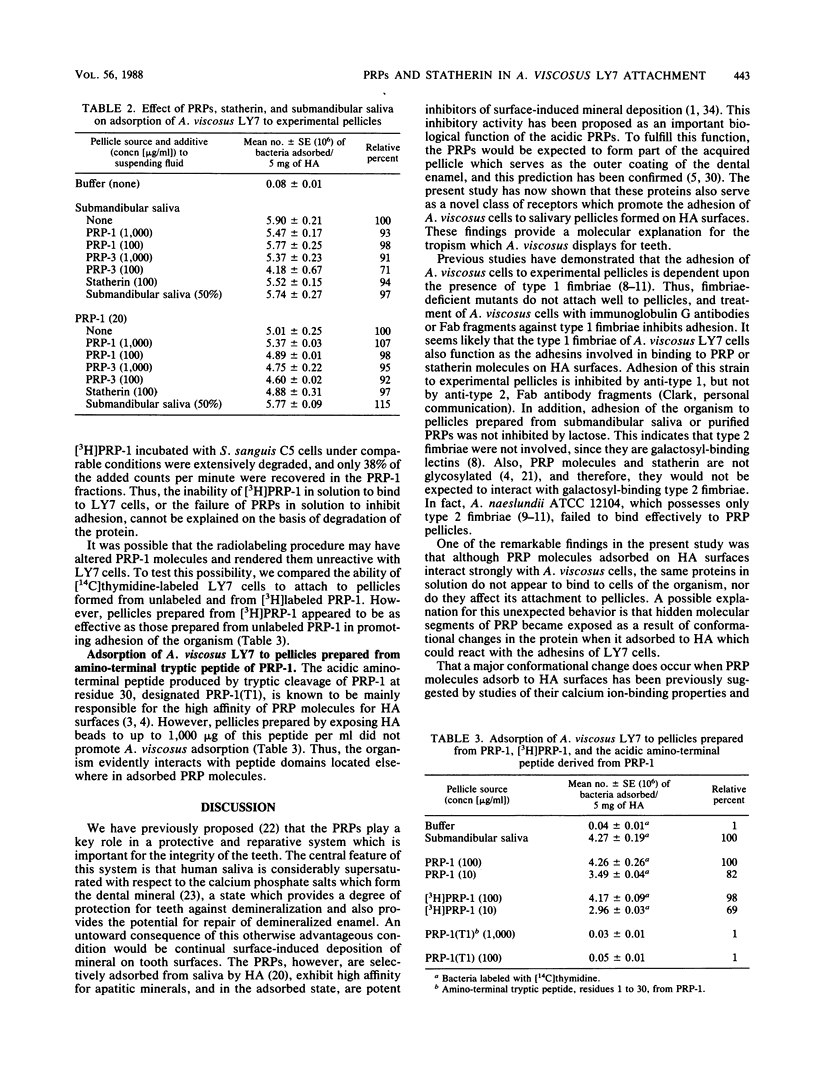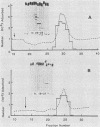Abstract
Actinomyces viscosus LY7 cells adsorbed in high numbers to experimental pellicles formed on hydroxyapatite (HA) from human parotid or submandibular saliva but not to pellicles prepared from human plasma or serum. To determine the nature of the salivary components responsible for promoting adhesion, pellicles were prepared from fractions of submandibular and parotid saliva obtained by chromatography on Trisacryl GF 2000 columns. Adsorption of LY7 cells was promoted by two groups of fractions. Each group was rechromatographed on DEAE-agarose. Fractions which promoted adsorption of LY7 cells were found by polyacrylamide gel electrophoresis to contain the acidic proline-rich proteins (PRPs) and statherin. Pellicles prepared from 12-micrograms/ml solutions of pure PRP-1, PRP-2, or parotid isoelectric focusing (PIF-slow) variant promoted maximal adsorption of A. viscosus LY7 cells. Somewhat higher concentrations of PRP-3 and PRP-4 were required for maximal adsorption, indicating that the 44-residue carboxy-terminal segment of PRP-1, PRP-2, and PIF-slow enhances LY7 binding but is not essential. Much higher concentrations of statherin were required to promote LY7 adsorption. Adsorption of LY7 cells to pellicles prepared from PRP-1 was not affected over the range of pH 5 to 8. Adsorption was also not inhibited by 50 mM lactose, which is consistent with the notion that type 1 fimbriae, rather than type 2 fimbriae, were responsible. A. viscosus T14, Actinomyces odontolyticus ATCC 17982, and Actinomyces israelii 12597 also adsorbed to PRP-1 pellicles, whereas Actinomyces naeslundii ATCC 12104 did not. Although A. viscosus cells bind strongly to adsorbed PRP-1, the presence of PRP-1 or PRP-3 in solution did not inhibit adhesion. Similarly, [3H]PRP-1 did not bind to LY7 cells, nor was it degraded when incubated with the organism. However, LY7 cells adsorbed to [3H]PRP-1 pellicles. These data suggest that hidden molecular segments of PRP become exposed when the protein adsorbs to HA; these segments then react with adhesins of LY7 cells. The apparent ability of A. viscosus cells to recognize segments of PRPs which are exposed only in surface-adsorbed molecules provides a novel mechanism which enables the organism to attach to teeth when suspended in salivary secretions.
Full text
PDF






Images in this article
Selected References
These references are in PubMed. This may not be the complete list of references from this article.
- Aoba T., Moreno E. C., Hay D. I. Inhibition of apatite crystal growth by the amino-terminal segment of human salivary acidic proline-rich proteins. Calcif Tissue Int. 1984 Dec;36(6):651–658. doi: 10.1007/BF02405385. [DOI] [PubMed] [Google Scholar]
- Azen E. A., Denniston C. Genetic polymorphism of PIF (parotid isoelectric focusing variant) proteins with linkage to the PPP (parotid proline-rich protein) gene complex. Biochem Genet. 1981 Jun;19(5-6):475–485. doi: 10.1007/BF00484620. [DOI] [PubMed] [Google Scholar]
- Bennick A., Cannon M., Madapallimattam G. The nature of the hydroxyapatite-binding site in salivary acidic proline-rich proteins. Biochem J. 1979 Oct 1;183(1):115–126. doi: 10.1042/bj1830115. [DOI] [PMC free article] [PubMed] [Google Scholar]
- Bennick A., Chau G., Goodlin R., Abrams S., Tustian D., Madapallimattam G. The role of human salivary acidic proline-rich proteins in the formation of acquired dental pellicle in vivo and their fate after adsorption to the human enamel surface. Arch Oral Biol. 1983;28(1):19–27. doi: 10.1016/0003-9969(83)90022-5. [DOI] [PubMed] [Google Scholar]
- Bennick A., Connell G. E. Purification and partial characterization of four proteins from human parotid saliva. Biochem J. 1971 Jul;123(3):455–464. doi: 10.1042/bj1230455. [DOI] [PMC free article] [PubMed] [Google Scholar]
- Bennick A., McLaughlin A. C., Grey A. A., Madapallimattam G. The location and nature of calcium-binding sites in salivary acidic proline-rich phosphoproteins. J Biol Chem. 1981 May 25;256(10):4741–4746. [PubMed] [Google Scholar]
- Bennick A. Structural and genetic aspects of proline-rich proteins. J Dent Res. 1987 Feb;66(2):457–461. doi: 10.1177/00220345870660021201. [DOI] [PubMed] [Google Scholar]
- CURBY W. A. Device for collection of human parotid saliva. J Lab Clin Med. 1953 Mar;41(3):493–496. [PubMed] [Google Scholar]
- Cisar J. O., Sandberg A. L., Mergenhagen S. E. The function and distribution of different fimbriae on strains of Actinomyces viscosus and Actinomyces naeslundii. J Dent Res. 1984 Mar;63(3):393–396. doi: 10.1177/00220345840630030701. [DOI] [PubMed] [Google Scholar]
- Clark W. B., Wheeler T. T., Cisar J. O. Specific inhibition of adsorption of Actinomyces viscosus T14V to saliva-treated hydroxyapatite by antibody against type 1 fimbriae. Infect Immun. 1984 Feb;43(2):497–501. doi: 10.1128/iai.43.2.497-501.1984. [DOI] [PMC free article] [PubMed] [Google Scholar]
- Clark W. B., Wheeler T. T., Lane M. D., Cisar J. O. Actinomyces adsorption mediated by type-1 fimbriae. J Dent Res. 1986 Sep;65(9):1166–1168. doi: 10.1177/00220345860650091001. [DOI] [PubMed] [Google Scholar]
- DAVIS B. J. DISC ELECTROPHORESIS. II. METHOD AND APPLICATION TO HUMAN SERUM PROTEINS. Ann N Y Acad Sci. 1964 Dec 28;121:404–427. doi: 10.1111/j.1749-6632.1964.tb14213.x. [DOI] [PubMed] [Google Scholar]
- Ellen R. P., Banting D. W., Fillery E. D. Longitudinal microbiological investigation of a hospitalized population of older adults with a high root surface caries risk. J Dent Res. 1985 Dec;64(12):1377–1381. doi: 10.1177/00220345850640121001. [DOI] [PubMed] [Google Scholar]
- Ellen R. P. Establishment and distribution of Actinomyces viscosus and Actinomyces naeslundii in the human oral cavity. Infect Immun. 1976 Nov;14(5):1119–1124. doi: 10.1128/iai.14.5.1119-1124.1976. [DOI] [PMC free article] [PubMed] [Google Scholar]
- Ellen R. P., Fillery E. D., Chan K. H., Grove D. A. Sialidase-enhanced lectin-like mechanism for Actinomyces viscosus and Actinomyces naeslundii hemagglutination. Infect Immun. 1980 Feb;27(2):335–343. doi: 10.1128/iai.27.2.335-343.1980. [DOI] [PMC free article] [PubMed] [Google Scholar]
- Ellen R. P., Segal D. N., Grove D. A. Relative proportions of Actinomyces viscosus and Actinomyces naeslundii in dental plaques collected from single sites. J Dent Res. 1978 Apr;57(4):550–550. doi: 10.1177/00220345780570040201. [DOI] [PubMed] [Google Scholar]
- Gibbons R. J., Etherden I. Albumin as a blocking agent in studies of streptococcal adsorption to experimental salivary pellicles. Infect Immun. 1985 Nov;50(2):592–594. doi: 10.1128/iai.50.2.592-594.1985. [DOI] [PMC free article] [PubMed] [Google Scholar]
- Gibbons R. J., Etherden I. Enzymatic modification of bacterial receptors on saliva-treated hydroxyapatite surfaces. Infect Immun. 1982 Apr;36(1):52–58. doi: 10.1128/iai.36.1.52-58.1982. [DOI] [PMC free article] [PubMed] [Google Scholar]
- Hay D. I., Schluckebier S. K., Moreno E. C. Equilibrium dialysis and ultrafiltration studies of calcium and phosphate binding by human salivary proteins. Implications for salivary supersaturation with respect to calcium phosphate salts. Calcif Tissue Int. 1982;34(6):531–538. doi: 10.1007/BF02411299. [DOI] [PubMed] [Google Scholar]
- Hay D. I., Smith D. J., Schluckebier S. K., Moreno E. C. Relationship between concentration of human salivary statherin and inhibition of calcium phosphate precipitation in stimulated human parotid saliva. J Dent Res. 1984 Jun;63(6):857–863. doi: 10.1177/00220345840630060901. [DOI] [PubMed] [Google Scholar]
- Hay D. I. The interaction of human parotid salivary proteins with hydroxyapatite. Arch Oral Biol. 1973 Dec;18(12):1517–1529. doi: 10.1016/0003-9969(73)90127-1. [DOI] [PubMed] [Google Scholar]
- Isemura S., Saitoh E., Sanada K. The amino acid sequence of a salivary proline-rich peptide, P-C, and its relation to a salivary proline-rich phosphoprotein, protein C. J Biochem. 1980 Apr;87(4):1071–1077. [PubMed] [Google Scholar]
- JORDAN H. V., KEYES P. H. AEROBIC, GRAM-POSITIVE, FILAMENTOUS BACTERIA AS ETIOLOGIC AGENTS OF EXPERIMENTAL PERIODONTAL DISEASE IN HAMSTERS. Arch Oral Biol. 1964 Jul-Aug;9:401–414. doi: 10.1016/0003-9969(64)90025-1. [DOI] [PubMed] [Google Scholar]
- Jentoft N., Dearborn D. G. Labeling of proteins by reductive methylation using sodium cyanoborohydride. J Biol Chem. 1979 Jun 10;254(11):4359–4365. [PubMed] [Google Scholar]
- Kousvelari E. E., Baratz R. S., Burke B., Oppenheim F. G. Immunochemical identification and determination of proline-rich proteins in salivary secretions, enamel pellicle, and glandular tissue specimens. J Dent Res. 1980 Aug;59(8):1430–1438. doi: 10.1177/00220345800590081201. [DOI] [PubMed] [Google Scholar]
- Loesche W. J., Syed S. A. Bacteriology of human experimental gingivitis: effect of plaque and gingivitis score. Infect Immun. 1978 Sep;21(3):830–839. doi: 10.1128/iai.21.3.830-839.1978. [DOI] [PMC free article] [PubMed] [Google Scholar]
- Maeda N., Kim H. S., Azen E. A., Smithies O. Differential RNA splicing and post-translational cleavages in the human salivary proline-rich protein gene system. J Biol Chem. 1985 Sep 15;260(20):11123–11130. [PubMed] [Google Scholar]
- Mandel I. D., Bennick A. Quantitation of human salivary acidic proline-rich proteins in oral diseases. J Dent Res. 1983 Sep;62(9):943–945. doi: 10.1177/00220345830620090501. [DOI] [PubMed] [Google Scholar]
- Moreno E. C., Kresak M., Hay D. I. Adsorption thermodynamics of acidic proline-rich human salivary proteins onto calcium apatites. J Biol Chem. 1982 Mar 25;257(6):2981–2989. [PubMed] [Google Scholar]
- Moreno E. C., Varughese K., Hay D. I. Effect of human salivary proteins on the precipitation kinetics of calcium phosphate. Calcif Tissue Int. 1979 Aug 24;28(1):7–16. doi: 10.1007/BF02441212. [DOI] [PubMed] [Google Scholar]
- Oppenheim F. G., Hay D. I., Franzblau C. Proline-rich proteins from human parotid saliva. I. Isolation and partial characterization. Biochemistry. 1971 Nov;10(23):4233–4238. doi: 10.1021/bi00799a013. [DOI] [PubMed] [Google Scholar]
- Oppenheim F. G., Offner G. D., Troxler R. F. Amino acid sequence of a proline-rich phosphoglycoprotein from parotid secretion of the subhuman primate Macaca fascicularis. J Biol Chem. 1985 Sep 5;260(19):10671–10679. [PubMed] [Google Scholar]
- Oppenheim F. G. Preliminary observations on the presence and origin of serum albumin in human saliva. Helv Odontol Acta. 1970 Apr;14(1):10–17. [PubMed] [Google Scholar]
- Qureshi J. V., Gibbons R. J. Differences in the adsorptive behavior of human strains of Actinomyces viscosus and Actinomyces naeslundii to saliva-treated hydroxyapatite surfaces. Infect Immun. 1981 Jan;31(1):261–266. doi: 10.1128/iai.31.1.261-266.1981. [DOI] [PMC free article] [PubMed] [Google Scholar]
- Schlesinger D. H., Hay D. I. Complete covalent structure of a proline-rich phosphoprotein, PRP-2, an inhibitor of calcium phosphate crystal growth from human parotid saliva. Int J Pept Protein Res. 1986 Apr;27(4):373–379. doi: 10.1111/j.1399-3011.1986.tb01030.x. [DOI] [PubMed] [Google Scholar]
- Sumney D. L., Jordan H. V. Characterization of bacteria isolated from human root surface carious lesions. J Dent Res. 1974 Mar-Apr;53(2):343–351. doi: 10.1177/00220345740530022701. [DOI] [PubMed] [Google Scholar]
- Syed S. A., Loesche W. J. Bacteriology of human experimental gingivitis: effect of plaque age. Infect Immun. 1978 Sep;21(3):821–829. doi: 10.1128/iai.21.3.821-829.1978. [DOI] [PMC free article] [PubMed] [Google Scholar]
- Wong R. S., Bennick A. The primary structure of a salivary calcium-binding proline-rich phosphoprotein (protein C), a possible precursor of a related salivary protein A. J Biol Chem. 1980 Jun 25;255(12):5943–5948. [PubMed] [Google Scholar]
- Wong R. S., Hofmann T., Bennick A. The complete primary structure of a proline-rich phosphoprotein from human saliva. J Biol Chem. 1979 Jun 10;254(11):4800–4808. [PubMed] [Google Scholar]




